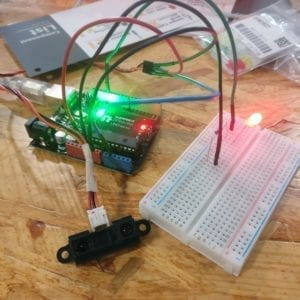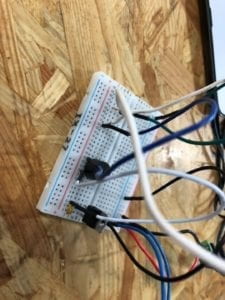- Step 1: Build the circuit


The circuits are really confusing!!! thanks to various colors of the wires, I finally made it! I used the 5v first, instead of the power, which helps to protect my computer and arduino.
- Step 2: Control rotation with a potentiometer

After adding a potentiometer, I used the the function “map()” to match the movement of the knob with the rotation of the motor. The code is “float val=0; val=map( val, 1023, 0, 200,0);”. After coding, the motor rotated according to the movement of the knob!
- Step 3: Build a Drawing Machine!
My friend Hangkai built the machine together. We used 5 paper fasteners, 2 laser-cut arms, 1 laser-cut motor holder, and one 3D printed motor coupling. When we used our machine to draw, the drawing looked like some doodles drawn by kindergarten children. But it was happy and worthy!

- Question 1:
I would be interested in building a machine to help me find my things. Because I always fail to find my things and can’t remember where I had put them. So I want to build a robot which can help me to find and get my things accuratly. I can use some chips to stick on my easy-losing things like phones or bottles. (The chips can as light as paper). Then the robot can connect to those chips and locate to those things according to the chips, and report their locations. If I don’t want to get them by myself, it can help me to get! They will have wheels, motors, and distance sensors. Also, because I sleep upper, so this machine can also help me to get things from my desk or ground to my bed.
-
Question 2:
I was impressed by the work “The Drumming and Drawing Subhuman”. I think this project is creative. Considered it was built in 2000( quite early), it is fantasy to see the movements of the robort were trying to mimic the actions of human, to play drum, to throw stone or to try to stand up. Compared with the drawing machine, I think both of them tried to imitate human actions,but the drumming robort is more human-like and have more actions( more complicated). I think the artisit used motors to control the robort’s legs and arms so that they can move up and down freely, also, it can change the strength and frequency that hit on the drums in order to change the tone.

















